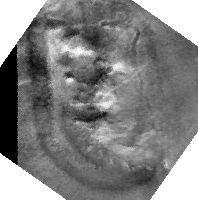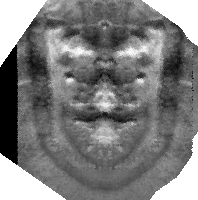Additional Subfields From April 1998 MGS Cydonia Flyover
Tom Van Flandern, Meta Research -- 98/06
Cydonia Articles
Additional Subfields From April 1998 MGS Cydonia FlyoverArtificial Structures on Mars -- DC Press Conference
Artificial Structures on Mars -- NYC Press Conference
New Evidence of Artificiality at Cydonia on Mars
Preliminary analysis of 2001 April 8 Cydonia Face image
Preliminary Analysis of April 5 Cydonia Image from the Mars Global Surveyor Spacecraft
PROOF THAT THE CYDONIA FACE ON MARS IS ARTIFICIAL
Summary of the Exploded Planet Hypothesis (eph)
The 'Symbols' on Mars
The Cydonia Region of Mars
Click on one of the following thumbnails to view the full-sized image.
An extract from the top portion of the third MGS-Cydonia strip image taken April 23. This shows a set of embedded triangular features. Triangles are rare phenomena on moon and planet surfaces except at Cydonia, where many triangles and other features composed of linear sections are seen.
An extract from the top portion of the third MGS-Cydonia strip image taken April 23. This shows an unusual feature with dark stripes or bands. The feature is a few hundred meters long, and somewhat resembles a large lizard. Material sliding down the smooth pyramid-like face behind this object has been suggested as a possible natural explanation. We show it here because, just above (behind?) the dark stripes is an almost identical set of fainter dark stripes, as if a reflection were being seen. Likewise, irregular shapes to the right along the base of this smooth face also have fainter (mirror?) images "behind" them. If these were reflections, the presence of manufactured materials such as glass or metal would be implied.
This shows the triangular eyebrow feature just above the west eye socket on the Face. All three sides are apparently linear, and the bright portions are apparently on a front section facing directly into the Sun.

Mark Carlotto's ortho-rectified view of the Face. This uses height information from the Viking photos to reconstruct how the Face mesa would appear if viewed right-side-up from above. Naturally, only features on the visible west side are present in this image. East-side features were hidden behind the nose ridge and are therefore nearly blank in this rectified view.

If we make the assumption that the east side is a mirror image of the west side, this is the resulting rectified view. Only east side information was inserted; while the west side is still identical with the rectified view above. If we take this view and ask the computer to reconstruct what we would see from a 45-degree west viewing angle with sunlight eliminating contrast for illuminated east-side features, we would arrive at an image rather similar to what MGS actually saw. (Of course, an east-side that was not symmetric would also work. This merely shows that perfect symmetry is consistent with both Viking and MGS data.)



